The Mechanical Properties and Microstructure of Tailing Recycled Aggregate Concrete
Abstract
:1. Introduction
2. Research Significance
3. Materials and Methods
3.1. Materials
3.1.1. Cement and IOTs
3.1.2. Aggregates
3.1.3. Water-Reducing Agent
3.2. Mixing Proportion
3.3. Test Method
3.3.1. Deformation Property
3.3.2. Micrograph Test
3.3.3. Pore Structure
4. Result and Discussion
4.1. Deformation Property
4.1.1. Axial Compressive Strength
4.1.2. Peak Strain
4.1.3. Elastic Modulus
4.1.4. Energy Dissipation Capacity
4.2. SEM Analysis
4.3. Pore Structure
5. Conclusions
- (1)
- The axial compressive strength and energy dissipation capacity of concrete first increased and then decreased when the IOT incorporation ratio continued to increase. The concrete containing 30% IOTs exhibited the highest axial compressive strength and energy dissipation capacity.
- (2)
- The peak strain and elastic modulus in all of the IOT groups were superior to those in NAC and RAC. The mechanical test shows that TRAC’s mechanical properties were the best when the IOT content was 30%, on the whole.
- (3)
- The SEM analysis revealed that RAC had a slightly loose microstructure distribution compared with NAC. Some cracks were observed on the surface of RCA and a large number of hexagonal flake Ca(OH)2 crystals were found in the matrix. The EDS analysis showed that the content of C-S-H gel in the new ITZ was higher than that in the old ITZ. The content of C-S-H gel was much higher in TRAC than in RAC and NAC, and the microstructure of TRAC was denser and uniform. A large number of rose-petal-like AFm molecules were observed at the junction of the IOTs and cement matrix. This SEM observation was consistent with the mechanical properties. A few cracks with a width of about 0.2 μm were observed on the surface of IOT particles. This might be the reason that excessive IOTs weakened the strength of concrete. Meanwhile, the hardness of IOTs was lower than that of silica sand. Therefore, the amount of IOTs must be controlled.
- (4)
- IOTs can effectively reduce the porosity, pore size, and pore number of concrete, the porosity was the smallest when the content of IOTs was 30%. However, when excessive IOTs were added, the number of pores increased significantly.
Author Contributions
Funding
Institutional Review Board Statement
Informed Consent Statement
Data Availability Statement
Conflicts of Interest
Abbreviations
| TRAC | Recycled aggregate concrete containing iron ore tailings |
| IOTs | Iron ore tailings |
| NCA | Natural coarse aggregate |
| NAC | Natural aggregate concrete |
| RCA | Recycled coarse aggregate |
| RAC | Recycled aggregate concrete |
| ITZ | Interfacial transition zone |
| SEM | Scanning electron microscope |
| C-S-H | Calcium silicate hydrate |
| AFm | Monosulfate calcium sulfoaluminate hydrate |
| NMR | Nuclear magnetic resonance |
References
- Chiranjeevi, K.; Yatish, R.G.; Kumar, D.H.; Mulangi, R.H.; Shankar, A.R. Utilization of recycled concrete aggregates for pavement base courses—A detailed laboratory study. Constr. Build. Mater. 2024, 411, 134122. [Google Scholar] [CrossRef]
- Fernández, V.R.; de la Villa Mencía, R.V.; Rojas, M.F.; Giménez, R.G.; Moreno-Juez, J.; de Soto García, I.S. Construction and demolition waste in cement matrices as sinkholes of atmospheric pollution: Effect of the 2022 airborne dust in the Iberian Peninsula. J. Hazard. Mater. 2024, 464, 132929. [Google Scholar] [CrossRef]
- Malazdrewicz, S.; Ostrowski, K.A.; Sadowski, Ł. Self-compacting concrete with recycled coarse aggregates from concrete construction and demolition waste—Current state-of-the art and perspectives. Constr. Build. Mater. 2023, 370, 130702. [Google Scholar] [CrossRef]
- Kumar, V.V.; Bhikshma, V.; Prasad, B.V. Study on fresh and mechanical properties for different grades of geopolymer concrete with recycled coarse aggregate. Mater. Today Proc. 2022, 60, 708–714. [Google Scholar] [CrossRef]
- Alyaseen, A.; Poddar, A.; Kumar, N.; Sihag, P.; Lee, D.; Kumar, R.; Singh, T. Assessing the compressive and splitting tensile strength of self-compacting recycled coarse aggregate concrete using machine learning and statistical techniques. Mater. Today Commun. 2024, 38, 107970. [Google Scholar] [CrossRef]
- Soni, N.; Shukla, D.K. Analytical study on mechanical properties of concrete containing crushed recycled coarse aggregate as an alternative of natural sand. Constr. Build. Mater. 2021, 266, 120595. [Google Scholar] [CrossRef]
- Liu, Y.; Ren, P.; Garcia-Troncoso, N.; Mo, K.H.; Ling, T.-C. Roles of enhanced ITZ in improving the mechanical properties of concrete prepared with different types of recycled aggregates. J. Build. Eng. 2022, 60, 105197. [Google Scholar] [CrossRef]
- You, F.; Nian, M.F.; Zheng, J.L.; Luo, S.R. Study on flexural fatigue performance of recycled aggregate concrete. J. Build. Struct. 2022, 43, 134–141. [Google Scholar]
- Panghal, H.; Kumar, A. Enhancing concrete performance: Surface modification of recycled coarse aggregates for sustainable construction. Constr. Build. Mater. 2024, 411, 134432. [Google Scholar] [CrossRef]
- Trivedi, S.S.; Sarangi, D.; Das, B.B.; Barbhuiya, S. Influence of multi-stage processing and mechano-chemical treatments on the hydration and microstructure properties of recycled aggregate concrete. Constr. Build. Mater. 2023, 409, 133993. [Google Scholar] [CrossRef]
- Chen, X.Y.; Zhou, Q.; Cheng, Z.Y.; Tu, Y.P. Effect of nano-SiO2 on the interface transition zone between old and new mortar of recycled concrete. Mater. Rep. 2022, 36 (Suppl. 2), 191–195. [Google Scholar]
- Liu, X.Y.; Liu, H.; Wang, X.J.; Zhu, P.H.; Chen, C.H.; Zhou, X.L. Sulfuric acid corrosion resistance of graphene oxide modified geopolymer recycled concrete. Mater. Rep. 2023, 37, 148–153. [Google Scholar]
- Xu, F.; Wang, S.L.; Li, T.; Liu, B.; Zhao, N.; Liu, K.N. The mechanical properties and resistance against the coupled deterioration of sulfate attack and freeze-thaw cycles of tailing recycled aggregate concrete. Constr. Build. Mater. 2021, 269, 121273. [Google Scholar] [CrossRef]
- Xu, F.; Wang, S.L.; Li, T.; Li, Z.J. Effect of metakaolin on the mechanical properties and pore characteristics of fiber-reinforced tailing recycled aggregate concrete. Structures 2022, 35, 15–25. [Google Scholar] [CrossRef]
- Xu, F.; Wang, S.; Li, T.; Liu, B.; Li, B.; Zhou, Y. Mechanical properties and pore structure of recycled aggregate concrete made with iron ore tailings and polypropylene fibers. J. Build. Eng. 2021, 33, 101572. [Google Scholar] [CrossRef]
- Xu, F.; Wang, S.; Li, T.; Liu, B.; Li, B.; Zhou, Y. The mechanical properties of tailing recycled aggregate concrete and its resistance to the coupled deterioration of sulfate attack and wetting–drying cycles. Structures 2020, 27, 2208–2216. [Google Scholar] [CrossRef]
- Danish, A.; Ozbakkaloglu, T.; Mosaberpanah, M.A.; Salim, M.U.; Bayram, M.; Yeon, J.H.; Jafar, K. Sustainability benefits and commercialization challenges and strategies of geopolymer concrete: A review. J. Build. Eng. 2022, 58, 105005. [Google Scholar] [CrossRef]
- Eugênio, T.M.C.; Fagundes, J.F.; Viana, Q.S.; Vilela, A.P.; Mendes, R.F. Study on the feasibility of using iron ore tailing (iot) on technological properties of concrete roof tiles. Constr. Build. Mater. 2021, 279, 122484. [Google Scholar] [CrossRef]
- Vescovi, P.H.T.; Bezerra, A.C.D.S.; Poggiali, F.S.J. Iron ore tailing (IOT) chemical composition and content impact on the physical, mechanical, and durability properties of blended cement. J. Build. Eng. 2023, 80, 108119. [Google Scholar] [CrossRef]
- JG 175-2007; Common Portland Cement. Ministry of Housing and Urban-Rural Construction of the People’s Republic of China: Beijing, China, 2007.
- JGJ 52-2006; Standard for Technical Requirements and Test Method of Sand and Crushed Stone (or Gravel) for Ordinary Concrete. Ministry of Construction of the People’s Republic of China: Beijing, China, 2006.
- Damdelen, O. Investigation of 30% recycled coarse aggregate content in sustainable concrete mixes. Constr. Build. Mater. 2018, 184, 408–418. [Google Scholar] [CrossRef]
- Al Shouny, A.; Issa, U.H.; Miky, Y.; Sharaky, I.A. Evaluating and selecting the best sustainable concrete mixes based on recycled waste materials. Case Stud. Constr. Mater. 2023, 19, e02382. [Google Scholar] [CrossRef]
- Kim, J.; Nciri, N.; Sicakova, A.; Kim, N. Characteristics of waste concrete powders from multi-recycled coarse aggregate concrete and their effects as cement replacements. Constr. Build. Mater. 2023, 398, 132525. [Google Scholar] [CrossRef]
- Singh, R.; Nayak, D.; Pandey, A.; Kumar, R.; Kumar, V. Effects of recycled fine aggregates on properties of concrete containing natural or recycled coarse aggregates: A comparative study. J. Build. Eng. 2022, 45, 103442. [Google Scholar] [CrossRef]
- JGJ 55-2011; Specification for Mix Proportion Design of Ordinary Concrete. Ministry of Construction of the People’s Republic of China: Beijing, China, 2011.
- Li, T.; Wang, S.L.; Xu, F.; Meng, X.Y.; Li, B.B.; Zhan, M. Study of the basic mechanical properties and degradation mechanism of recycled concrete with tailings before and after carbonation. J. Clean. Prod. 2020, 259, 120923. [Google Scholar] [CrossRef]
- GBT50081-2002; Standard for Test Method of Mechanical Properties on Ordinary Concrete. Ministry of Construction of the People’s Republic of China: Beijing, China, 2002.
- Zhou, X.; Xie, Y.; Long, G.; Zeng, X.; Li, J.; Wang, F. Simulating passing ability of self-compacting concrete in the J-ring test using cohesive particle liquid bridge model. Powder Technol. 2023, 416, 118218. [Google Scholar] [CrossRef]
- Zhao, Y.; Gong, Q.; Wu, Y.; Zornberg, J.G.; Tian, Z.; Zhang, X. Evolution of active arching in granular materials: Insights from load, displacement, strain, and particle flow. Powder Technol. 2021, 384, 160–175. [Google Scholar] [CrossRef]
- Kazmi, S.M.S.; Munir, M.J.; Wu, Y.-F.; Patnaikuni, I.; Zhou, Y.; Xing, F. Axial stress-strain behavior of macro-synthetic fiber reinforced recycled aggregate concrete. Cem. Concr. Compos. 2019, 97, 341–356. [Google Scholar] [CrossRef]
- Chen, A.; Han, X.; Chen, M.; Wang, X.; Wang, Z.; Guo, T. Mechanical and stress-strain behavior of basalt fiber reinforced rubberized recycled coarse aggregate concrete. Constr. Build. Mater. 2020, 260, 10–11. [Google Scholar] [CrossRef]
- Albidah, A.S. Influence of reclaimed asphalt pavement aggregate on the performance of metakaolin-based geopolymer concrete at ambient and elevated temperatures. Constr. Build. Mater. 2023, 402, 132945. [Google Scholar] [CrossRef]
- Kien, B.N.; Satomi, T.; Takahashi, H. Influence of industrial by-products and waste paper sludge ash on properties of recycled aggregate concrete. J. Clean. Prod. 2019, 214, 403–418. [Google Scholar]
- Thomas, B.S.; Damare, A.; Gupta, R.C. Strength and durability characteristics of copper tailing concrete. Constr. Build. Mater. 2013, 48, 894–900. [Google Scholar] [CrossRef]
- Fanella, D.A.; Naaman, A.E. Stress-strain properties of fibre reinforced mortar in compression. ACI J. Proc. 1985, 82, 475–483. [Google Scholar]
- Liu, H.Y.; Li, R. Analysis on strategies of eco-tourism landscape development in yibin city. J. Chengdu Univ. 2010, 29, 166–167+180. [Google Scholar]
- Im, S.; Liu, J.; Cho, S.; Moon, J.; Park, J.; Wi, K.; Seok, S.; Lim, S.; Bae, S. Quantitative characterization of the interfacial transition zone around lightweight and normal aggregates in cement mortars at different water-to-binder ratios. Constr. Build. Mater. 2023, 400, 132584. [Google Scholar] [CrossRef]
- Elsharief, A.; Cohen, M.D.; Olek, J. Influence of aggregate size, water cement ratio and age on the microstructure of the interfacial transition zone. Cem. Concr. Res. 2003, 33, 1837–1849. [Google Scholar] [CrossRef]
- Monteiro, J.J.M.; Mehta, P.K. Ettringite formation on the aggregate—Cement paste interface. Cem. Concr. Res. 1985, 15, 378–380. [Google Scholar] [CrossRef]
- Duan, P.; Yan, C.; Zhou, W.; Ren, D. Fresh properties, compressive strength and microstructure of fly ash geopolymer paste blended with iron ore tailing under thermal cycle. Constr. Build. Mater. 2016, 118, 76–88. [Google Scholar] [CrossRef]
- De Larrard, T.; Bastidas-Arteaga, E.; Duprat, F.; Schoefs, F. Effects of climate variations and global warming on the durability of RC structures subjected to carbonation. Civ. Eng. Environ. Syst. 2014, 31, 153–164. [Google Scholar] [CrossRef]

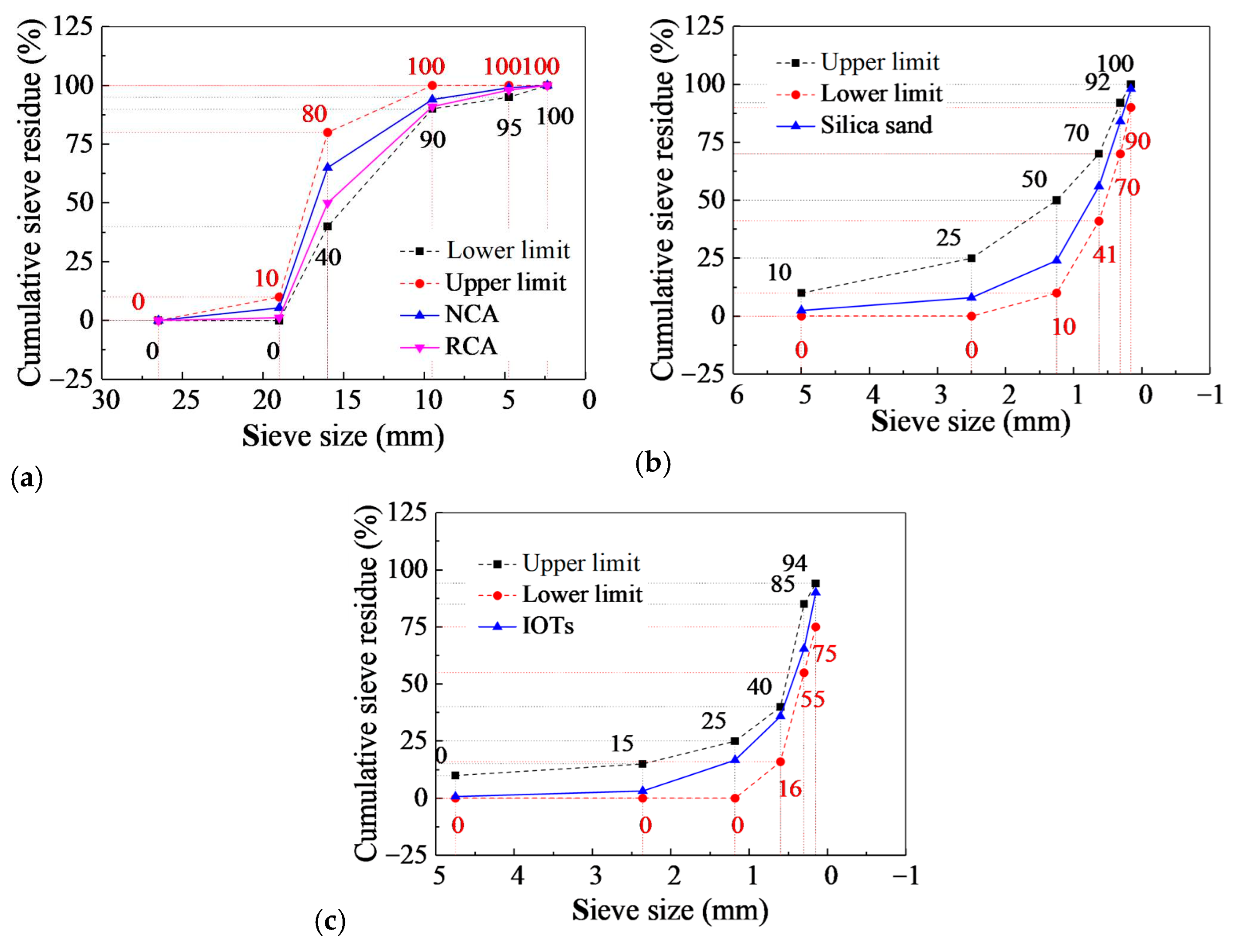
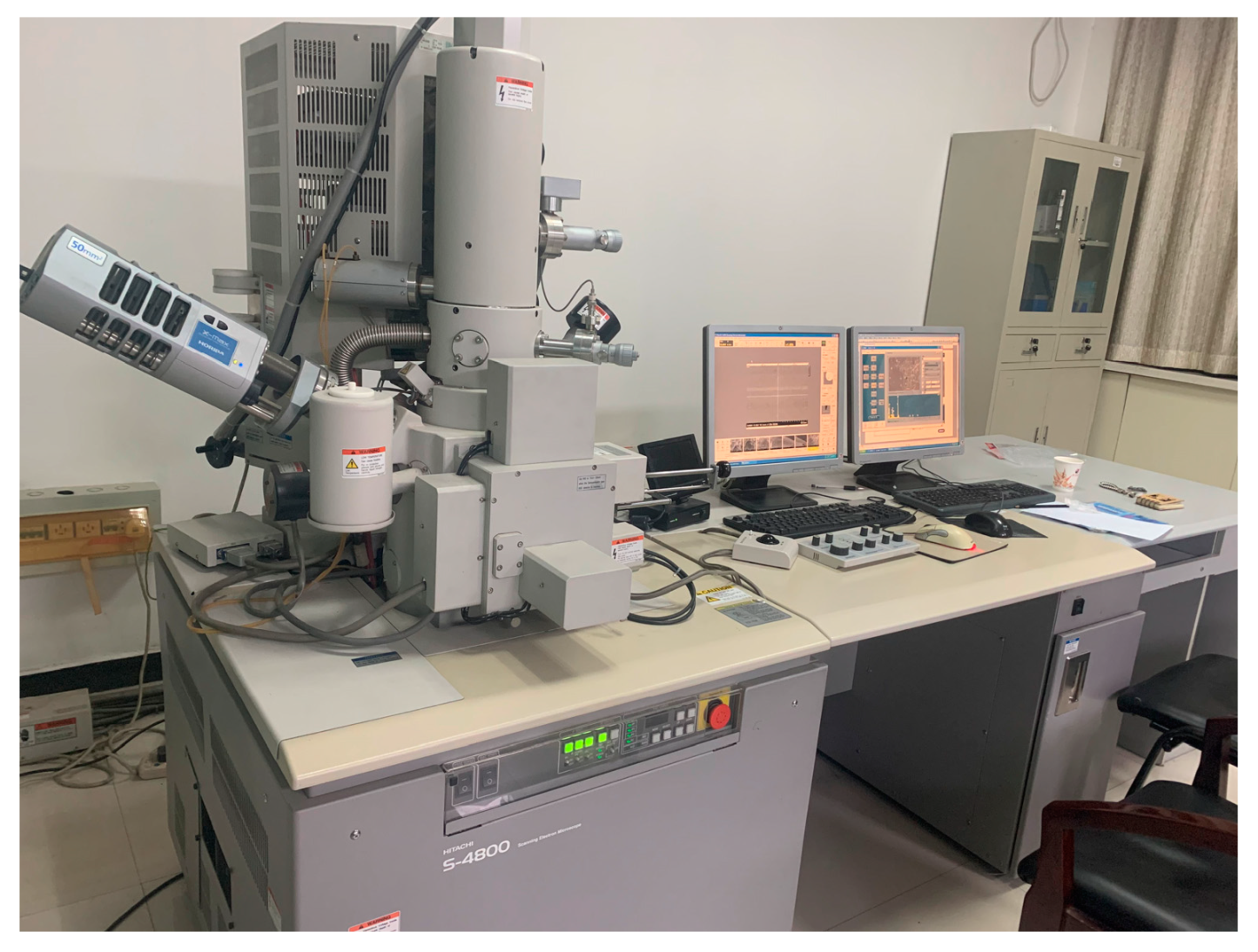
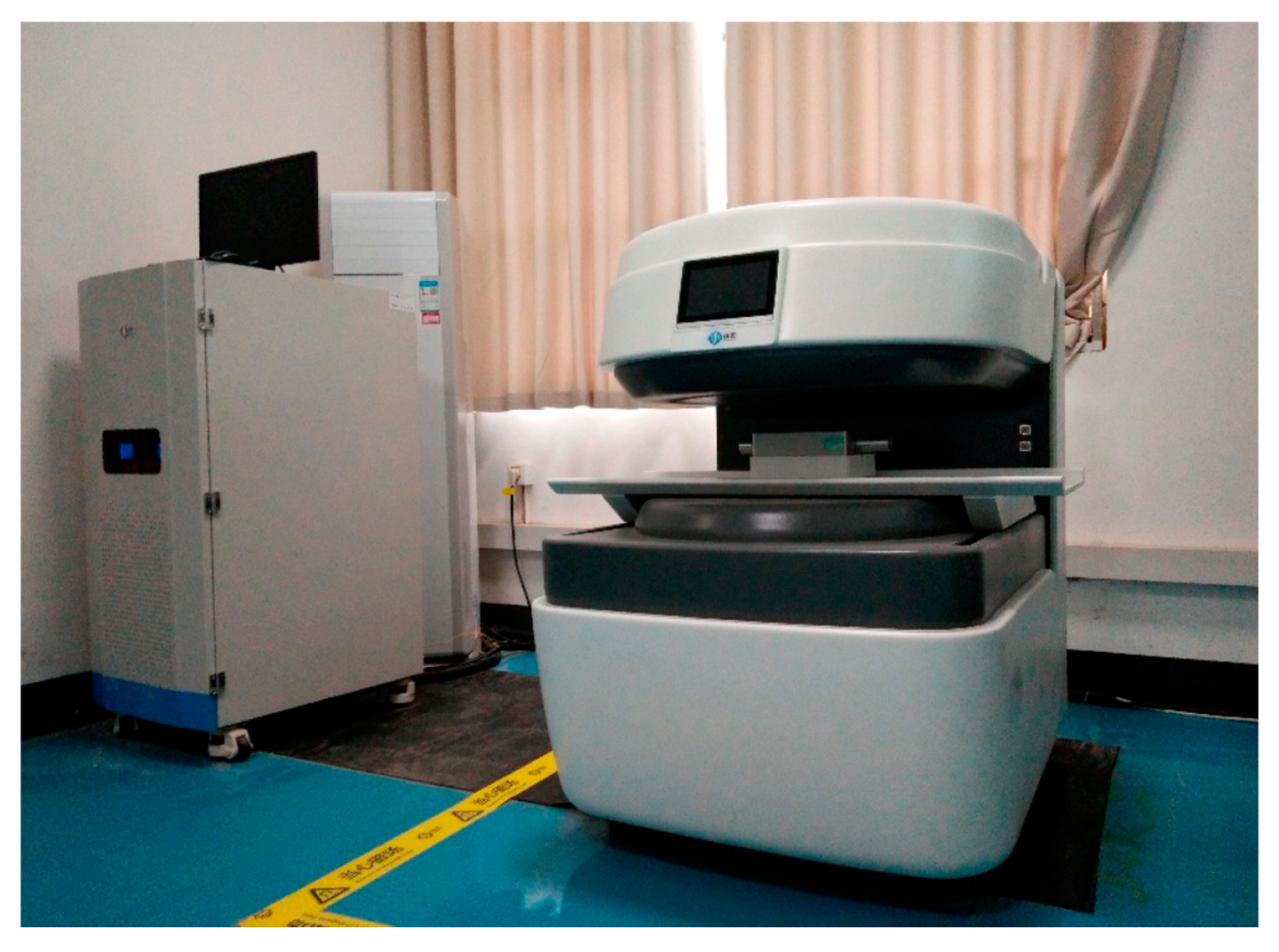
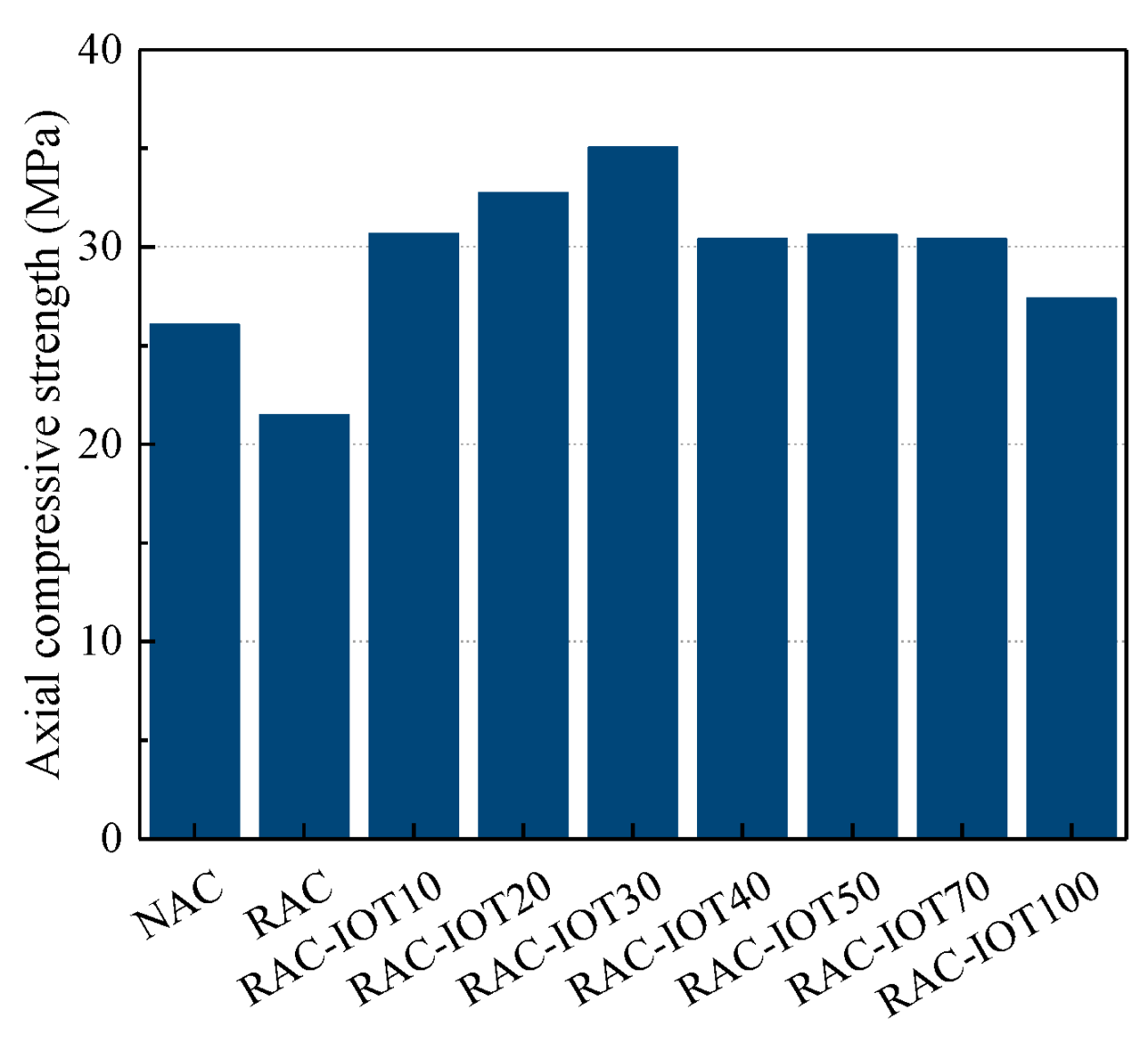
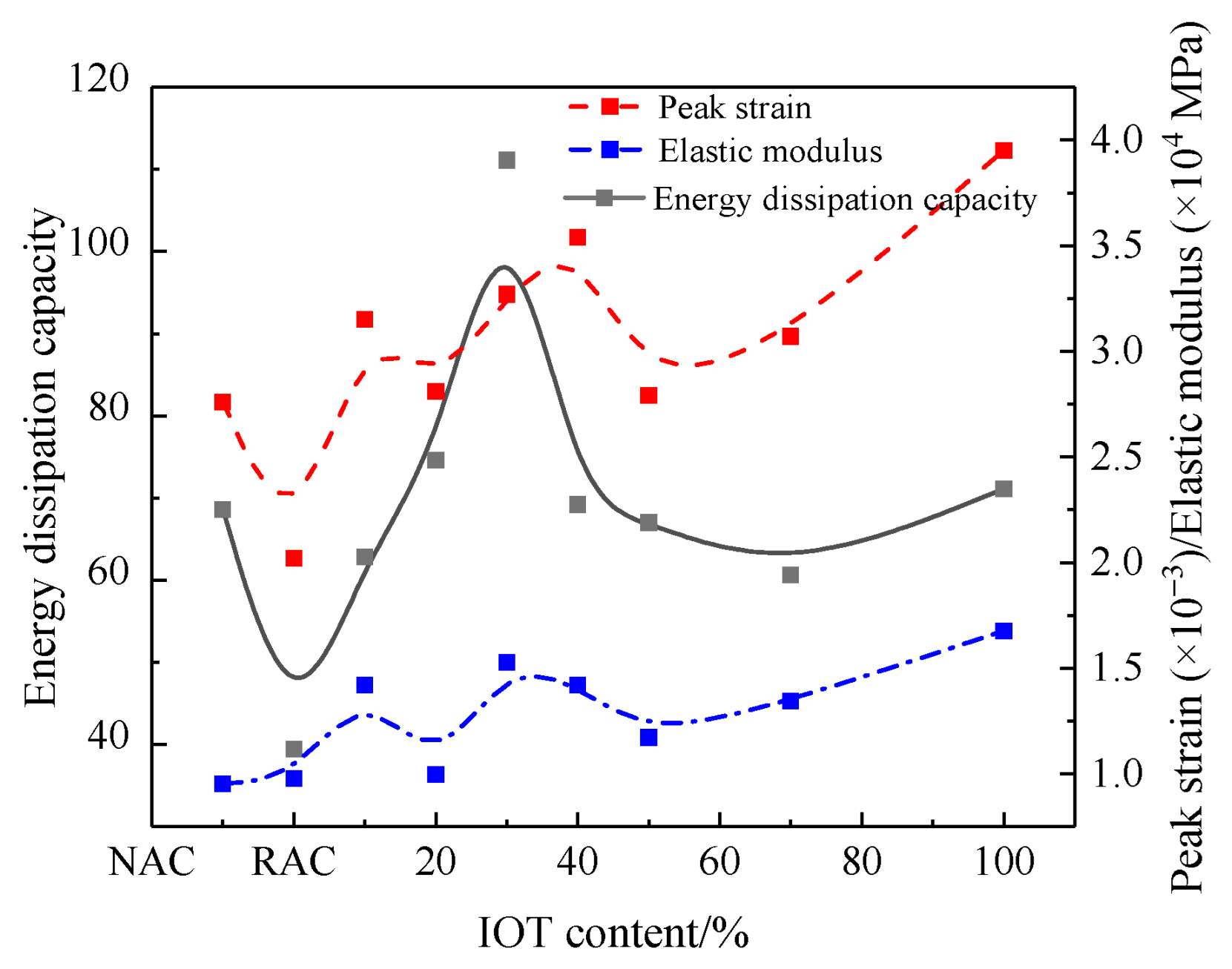
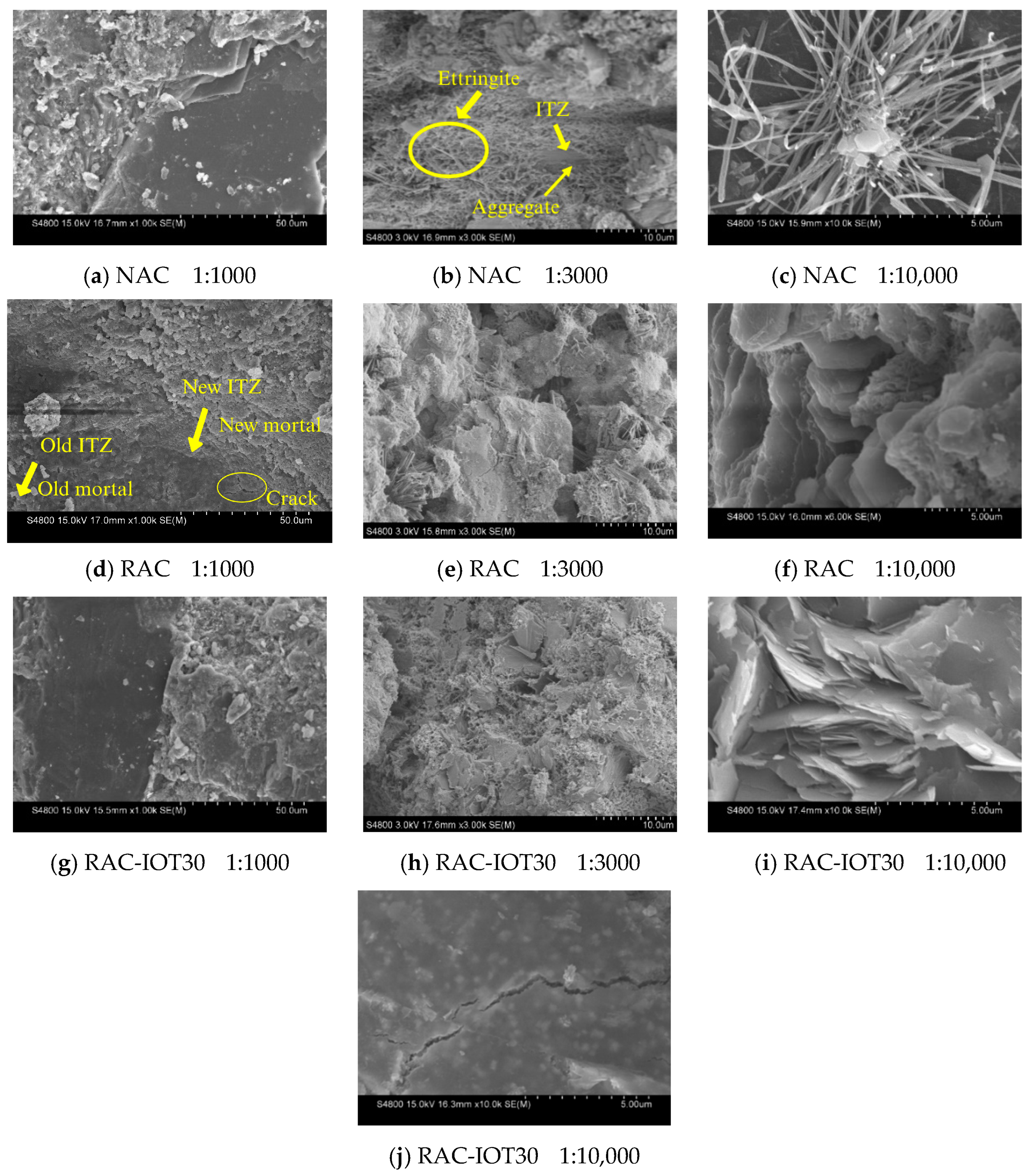

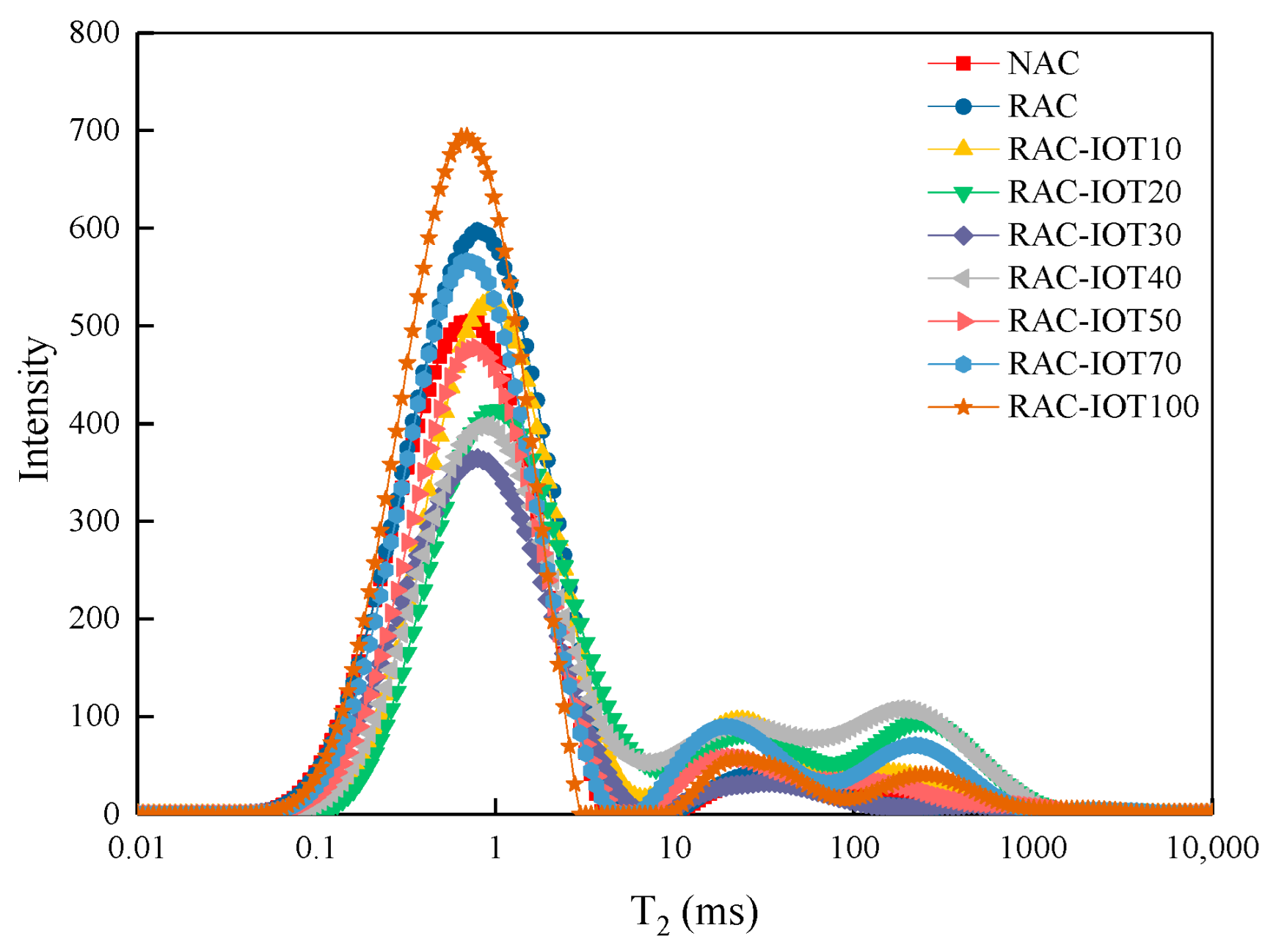
| Mineral Composition | C | O | Mg | Al | Si | S | K | Ca | Fe | Ti |
|---|---|---|---|---|---|---|---|---|---|---|
| Cement | 4.12 | 47.54 | 0.74 | 1.54 | 6.11 | 1.10 | 0.53 | 56.84 | 0.93 | 0.01 |
| IOTs | 0 | 56.49 | 6.95 | 8.38 | 17.46 | - | 3.02 | 1.68 | 5.28 | 0.74 |
| Standard Consistency Water Consumption (%) | Initial Setting Time (min) | Final Setting Times (min) | Fineness (45 μm) | Flexural Strength (MPa) | Compressive Strength (MPa) | ||
|---|---|---|---|---|---|---|---|
| 3d | 28d | 3d | 28d | ||||
| 28 | 160 | 280 | 2.8 | 5.2 | 6.8 | 19 | 42.2 |
| Performance Indicator | Apparent Density (kg/m3) | Bulk Density (kg/m3) | Crush Value (%) | Water Absorptivity (%) | Mud Content (%) | Moisture Content (%) | Organic Matter Content | Alkali Aggregate Reaction |
|---|---|---|---|---|---|---|---|---|
| NCA | 2941 | 1749 | 10.3 | 1.33 | 0.72 | 0.8 | Qualified | Qualified |
| RCA | 2536 | 1467 | 14.8 | 7 | 1.86 | 3.02 | Qualified | Qualified |
| Norm values of NCA | ≥2500 | ≥1300 | ≤16 | - | ≤1.0 | - | Qualified | Qualified |
| Silica sand | 2764 | 1830 | 12 | 2.12 | 1.2 | 4.1 | Qualified | Qualified |
| IOTs | 2745 | 1824 | 19.53 | 8.7 | 2.9 | 1.45 | Qualified | Qualified |
| Norm values of silica sand | - | - | ≤10 | - | ≤3.0 | - | Qualified | Qualified |
| Density (g/m3) | pH Values | Water Solubility | CL Content (%) | Na2SO4 Content (%) | R2O Content (%) |
|---|---|---|---|---|---|
| 1.05 ± 0.2 | 6~7 | Intermiscible | ≤1.0 | ≤2.0 | ≤5.0 |
| Specimen | Water (kg/m3) | Cement (kg/m3) | NCA (kg/m3) | RCA (kg/m3) | Silica Sand (kg/m3) | IOTs (kg/m3) |
|---|---|---|---|---|---|---|
| NAC | 215 | 537.5 | 1062.9 | 0 | 572.3 | 0 |
| RAC | 215 | 537.5 | 735.3 | 315.1 | 565.6 | 0 |
| RAC-IOT10 | 215 | 537.5 | 739.4 | 316.9 | 511.9 | 56.9 |
| RAC-IOT20 | 215 | 537.5 | 743.5 | 318.6 | 457.5 | 114.4 |
| RAC-IOT30 | 215 | 537.5 | 747.4 | 320.3 | 402.5 | 172.5 |
| RAC-IOT40 | 215 | 537.5 | 751.3 | 322.0 | 346.8 | 231.2 |
| RAC-IOT50 | 215 | 537.5 | 755.2 | 323.6 | 290.4 | 290.4 |
| RAC-IOT70 | 215 | 537.5 | 762.6 | 326.8 | 176.0 | 410.6 |
| RAC-IOT100 | 215 | 537.5 | 773.3 | 331.4 | 0 | 594.8 |
| Specimen | Porosity (%) | Specimen | Porosity (%) |
|---|---|---|---|
| NAC | 11.89 | RAC | 14.63 |
| RAC-IOT10 | 13.32 | RAC-IOT20 | 11.17 |
| RAC-IOT30 | 9.42 | RAC-IOT40 | 10.72 |
| RAC-IOT50 | 10.48 | RAC-IOT70 | 12.46 |
| RAC-IOT100 | 15.67 |
Disclaimer/Publisher’s Note: The statements, opinions and data contained in all publications are solely those of the individual author(s) and contributor(s) and not of MDPI and/or the editor(s). MDPI and/or the editor(s) disclaim responsibility for any injury to people or property resulting from any ideas, methods, instructions or products referred to in the content. |
© 2024 by the authors. Licensee MDPI, Basel, Switzerland. This article is an open access article distributed under the terms and conditions of the Creative Commons Attribution (CC BY) license (https://creativecommons.org/licenses/by/4.0/).
Share and Cite
Xu, F.; Li, Z.; Li, T.; Wang, S. The Mechanical Properties and Microstructure of Tailing Recycled Aggregate Concrete. Materials 2024, 17, 1058. https://doi.org/10.3390/ma17051058
Xu F, Li Z, Li T, Wang S. The Mechanical Properties and Microstructure of Tailing Recycled Aggregate Concrete. Materials. 2024; 17(5):1058. https://doi.org/10.3390/ma17051058
Chicago/Turabian StyleXu, Fan, Zhijun Li, Tao Li, and Sheliang Wang. 2024. "The Mechanical Properties and Microstructure of Tailing Recycled Aggregate Concrete" Materials 17, no. 5: 1058. https://doi.org/10.3390/ma17051058





